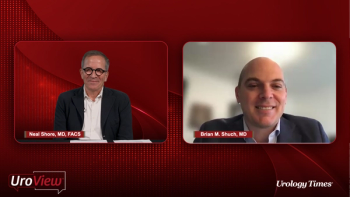
Practical Advice on Optimizing Peer-Peer Communication Regarding Imaging Results
A practical approach to how urologists might best communicate with radiologists and other clinicians regarding mpMRI results for patients with prostate cancer, with an emphasis on optimizing patient care.
Episodes in this series
Dr. Boris Gershman: If you have a patient with a straight-forward, cut, and dried PI-RADS 4 lesion on multi-parametric prostate MRI, there usually is no need for additional conversation or discussion with the radiologist. The caveat here is if it is an outside study, I will always request an interpretation internally, both to confirm the diagnosis of a PI-RADS 4 lesion, as well as to facilitate contouring and ensure that there is no secondary or tertiary lesions that may not have been identified on the initial report.
For a patient with multiple indeterminate lesions on the MRI, I will often discuss with a radiologist what their level of suspicion is, especially if this is a lesion that may represent, let's say, a BPH nodule or prostatitis, but because of enhancement or other characteristics, may be upgraded to something PI-RADS 3 to 5 that may warrant biopsy. In these cases, I think the utility is two-fold. First, to confirm the level of suspicion and need for biopsy, but also, it happens when there are multiple lesions that are close together. For instance, in cases of suspected prostatitis, versus real suspicious nodules that, if they are in close proximity, we may target the lesions together, and minimize the total number of targeted cores biopsied. So in these circumstances, I may reach out to a radiologist to confirm their suspicion and may even request that they contour lesions that are adjacent to one another into a larger, single contour to reduce the total number of target cores that are required for sampling.
For somebody with a suspicious follow-up MRI after a prior negative scan, this is actually a really interesting question. Part of it, I will look back to see if the same radiologist interpreted the studies or if different radiologists interpreted the studies. And this is one where I may actually frequently reach out to the interpreting radiologist to determine, has something truly changed? Does it look more suspicious now than before, or is this a situation where there is interpreter variability and it was not called previously and is being called now? Practically, I will usually err on the side of biopsying and sampling these lesions so as not to miss them when there is concern for suspicion, but these are great situations to have a conversation with your radiologist to really assess. Has something changed on the MRI or is it a difference of opinion, in terms of the interpretation? And, particularly true if you have outside studies with internal review that is discrepant.
In terms of other scenarios where communication directly with the radiologist may be beneficial, it really depends case-by-case, and partly, I judge based on the report. Sometimes the radiologist will insert some language in the report that suggests that a lesion may meet PI-RADS criteria, but their suspicion or gut feeling is that it likely represents a benign process like a BPH nodule or prostatitis. In these cases, I may reach out to the radiologist, just to get some more collateral information and then be able to advise the patient more accurately in terms of what the level of suspicion is, for proceeding with biopsy versus omitting biopsy.
The question of optimizing workflow for communicating between urologists and radiologists is an excellent one and starts and ends with relationships. I think to really trust the interpretation, you have to know your radiologists, partly through experience and this established relationship, and communication follows from that. If you have a relationship between the urologists and radiologists, then there's two-way communication and folks aren't afraid to reach out and either send an email or a text message or a phone call. I utilize all three methods for communicating with our radiologists here and, as mentioned before, we have a wonderful working relationship, both clinically as well as from a research standpoint. This is admittedly easier in consolidated health systems, where the radiologists and urologists may be at the same building or in the same region but is more challenging in decentralized settings and in community practices, where the radiologists may be at a different practice from the urologists and certainly geographically at a different location. That being said, if there's a strong relationship clinically between the clinicians, then having communication would still remain email, text, and phone. When I previously worked in a different environment where the radiology practice was separate from the urology practice, that was rarely the case. Email and phone still remained a wonderful way for communicating but it was really on the basis of having an established relationship that you could reach out to the radiologists and then they could reach out to you to discuss any questions, indeterminate results, and help formulate a plan for recommendations for the patients.
Newsletter
Stay current with the latest urology news and practice-changing insights — sign up now for the essential updates every urologist needs.
















